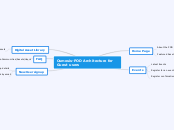Classical Receptors
Nuclear
Mechanism
heterodimerization with
retinoid X receptor
often causes dissociation
of co-repressor
co-activating protein
Heat shock proteins
in cytoplasm
Dissociation from HSP
HRE on target genes
Recruit co-activators/repressors
that effect gene transcription
Class II
Hybrid
Endocrine
RXR heterodimers
Lipid ligands
Intranuclear heterodimers
Class I
Endocrine ligands
Cytoplasmic homodimers
DNA recognition/binding domain
Ligand-gated ion channel
Examples
GABA Type A
Psychoactive drug targets
Binding of GABA to
alpha/beta interface
Nicotinic ACh receptor
Central aqueous
pore
Activation of channel
2 ACh binding regions
Pentameric complex
Sequence homology
Membrane localized
Ligand binding
Ion pore
Period of opening varies
Ligand or Agonist
Ion passage
Hyperpolarization or
Depolarization
Kinase-linked
Related receptors
Cytokine
Associate with cytosolic
tyrosine kinases
Serine/threonine kinases
GFR
Tyrosine kinases
Response to
bacterial infection
GFs
Transduction
Cytokine binding to extracellular domain
Allows binding of independent
cytoplasmic kinase
Activation of other proteins,
transcription factors
Intrinsic kinase activity
proteins bound to activated
intracellular domains
Recognizes phopshotyrosine domain
Links extracellular domain to
intracellular kinase domain
GPCR
Desensitization
Receptor internalization
Receptor phosphorylation
G-proteins
Activation
2. Release subunits
Beta and gamma reunite with
dissociated alpha, await recycle
Alpha subunit switches off
by self-hydrolysis of GTP
1. GDP --> GTP
Alpha, beta, gamma subunits
associate with ligand-bound
receptors
20 alpha isoforms
some activate, some inhibit
Subfamilies
Metaboropic glutamate
Calcium sensor
GABA
Secretin/glucagon
ligand binding domain
peptide hormones
Rhodopsin
extracellular helices or
hoops bind ligands
Amine NT, NP,
purines, cannabinoids
Structure
Intracellular g-protein
coupling domain
7 transmembrane
alpha helices
Membrane-localized
Pharmacodynamics Module 1









